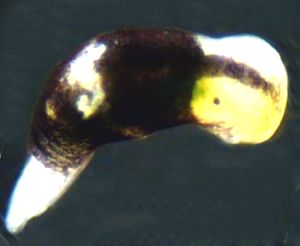
Limapontia capitata
(Muller, 1774)
Order: SACOGLOSSA
Superfamily: LIMAPONTIOIDEA
Family: Limapontiidae
DISTRIBUTION
European coast of north Atlantic from Iceland to the Mediterranean, Atlantic coast of Nth Africa.
PHOTO
Tjärnö, west coast of Sweden, from filamentous algae growing just below the water line on a floating jetty. Length about 2mm. November 2001. Photo: Mike Noren
Body-colour usually dark brown to black, with paler areas on either side of the head and sometimes in the middle of the dorsum. There are no rhinophores but Thompson (1976) describes a slightly rounded crest on each side of the head in adults. This is quite different from L. senestra where the head tentacles are distinct and digitiform in adults. The anal and renal openings are situated close together, postero-dorsally in the midline. Grows to 8mm but usually smaller, living in intertidal pools and shallow water. Feeds on filamentous green algae (Bryopsis, Cladophora, Enteromorpha).
References:
• Muller, O.F. (1774) Vermium terredtrium et fluviatilium Havniae & Lipsiae. Vol 2.
• Thompson,T.E. (1976) Biology of Opisthobranch Molluscs. Volume 1. The Ray Society, London. 207pp.
Rudman, W.B., 2004 (March 9) Limapontia capitata (Muller, 1774). [In] Sea Slug Forum. Australian Museum, Sydney. Available from http://www.seaslugforum.net/find/limacapi
Related messages
Re: Vaucheria? and Limapontia capitata
November 6, 2009
From: Skip Pierce
Concerning message #22753:
Hi Bill
I am certainly NOT an algae expert-especially outside of the east coast of the US (and if an algal pro sends a different answer, disregard everything I've said below), but I have spent decades collecting and culturing Vaucheria litorea for our work with Elysia chlorotica. Possibly the alga in these photos is indeed Vaucheria, but there are several sorts of non-descript, filamentous, mat-forming, marsh dwelling species that it might be. In situ, Vaucheria has a sort of distinctive muddy brown color, compared to the lighter, sort of chartrusey and bright greens of the chlorophytes (Vaucheria is a chromophyte), but I may be able to see both colors in the photos (and indeed Vaucheria and filamentous chlorophytes, like Enteromorpha, are often mixed in the same mat-and also indeed one of the photos in the message sort of looks like that). Best way to tell until you have had a lot of practice is to look at the filaments with a microscope. Vaucheria is coenocytic (has no cell walls). All of the other species that it might be will have obvious cells in the filaments. If there are no cell walls, then it PROBABLY is Vaucheria. Seems like I recall a paper or two on feeding of Limapontia?? but I can't put a finger on it. No doubt Kathe Jensen will know if such exists (and she may have written it!!)
Skip
pierce@cas.usf.edu
Pierce, S. K., 2009 (Nov 6) Re: Vaucheria? and Limapontia capitata. [Message in] Sea Slug Forum. Australian Museum, Sydney. Available from http://www.seaslugforum.net/find/22761Dear Skip,
Thanks for you comments. I remember how amazed I was the first time I checked out greenish filamentous algae under a microscope and saw just how different each species was. We have a message from Liz Summer's with a macrophoto of Vaucheria [message #1969].
Here a couple of relevant papers by Kathe:
-
Jensen, K. R. (1975). Food preference and food consumption in relation to growth of Limapontia capitata. Ophelia 14: 1-14.
-
Jensen, K. R. (1981). Observations on feeding methods in some Florida ascoglossans. Journal of Molluscan Studies 47: 190-199.
Best wishes,
Bill Rudman
Re: Limapontia capitata on Vaucheria
November 6, 2009
From: Kathe R. Jensen
Concerning message #22752:
Dear Bill and Ian,
The filamentous alga in this message looks more like it would be Rhizoclonium. It could be Chaetomorpha, but a very fine filamentous kind. Rhizoclonium often co-occurs with the more bluish-green Vaucheria. Vaucheria also tends to have a softer texture, though this may be difficult to assess since usually sediment adheres to the algal filaments. Limapontia capitata will feed on Rhizoclonium, but I have never seen it feeding on Vaucheria. The one picture with the triangular white spot is definitely L. capitata, whereas the other photos with a very short tail and rather broad head are more difficult to identify with certainty - without knowing the position of the anus (or shape of penial stylet).
Best wishes,
Kathe
krjensen@snm.ku.dk
Jensen, K.R., 2009 (Nov 6) Re: Limapontia capitata on Vaucheria. [Message in] Sea Slug Forum. Australian Museum, Sydney. Available from http://www.seaslugforum.net/find/22758Dear Kathe,
Thanks for your comments. Your mention of a 'short tail' reminded me I meant to mention that in Limapontia depressa the posterior part of the body is bluntly rounded with only a short 'tail' section of the foot extending beyond the main body mass. This differs from L. senestra and L. capitata in which there is quite a long tapering 'tail'.
Best wishes,
Bill Rudman
Vaucheria? and Limapontia capitata
November 5, 2009
From: Ian Smith
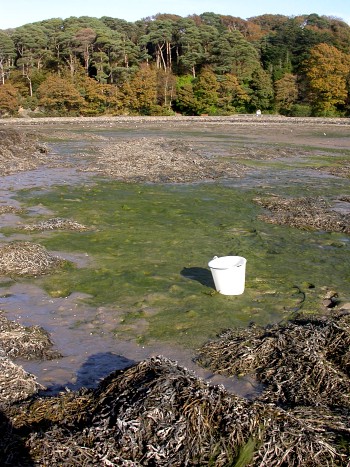
Concerning message #22752:
Dear Bill
Here are some more pictures of the "Vaucheria" on which I found Limapontia capitata [see message #22752].
Locality: Church Island, Menai, Anglesey, intertidal, Wales, U.K., Irish Sea, 17 October 2009, intertidal mud flat, full salinity. Length: 3 mm. Photographer: Ian F. Smith.
Perhaps someone experienced in marine algae can comment on the identification.
Cheers
Ian
ifsmith@bethere.co.uk
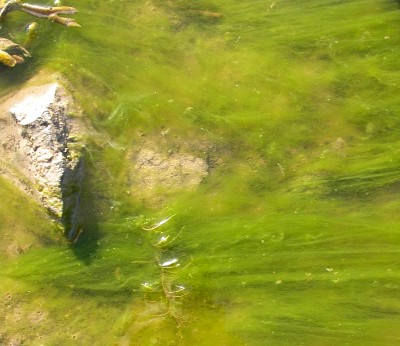
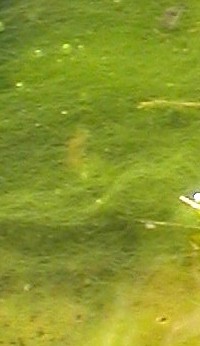
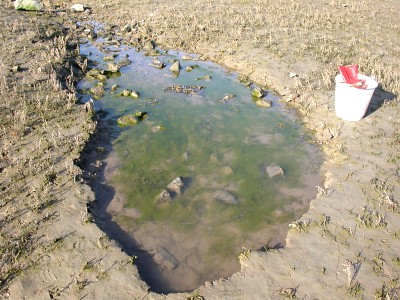
Thanks Ian,
Hopefully someone will be able to confirm or correct your identification
Best wishes,
Bill Rudman
Limapontia capitata on Vaucheria
November 5, 2009
From: Ian Smith
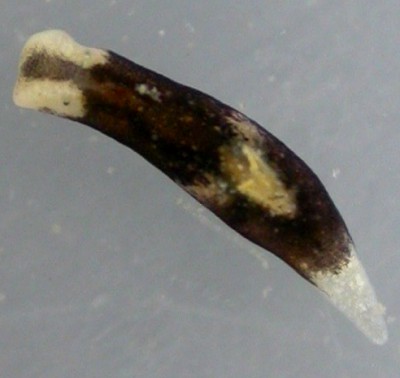
Note added 9 November 2009: The animals in the lower 3 photos are most likely L. depressa. See message #22763.
Dear Bill
I attach some pictures of Limapontia capitata. The rhinophoral crests can be seen fairly clearly on the brownish specimens, and the elongated pale metapodium is well extended on the dark specimen.
I found these in October 09 ,and others in Sept 09, in a bay adjoining the Swellies section of the Menai straights between Anglesey and mainland Wales.
They were found in conditions more usually associated with Limapontia depressa, except that the water in the Menai has full salinity. They were on Vaucheria. At least I think it is that; fine filaments forming a mat in mud pools among Salicornia europaea and on damp mud flats high on the shore. A couple of L. capitata were on it in a mud pool, but most were on the mat of "Vaucheria" lying on damp mud; a situation reported by T.E. Thompson (Biol. Opisth. Moll. vol.1,1976) as suited for L. depressa, while he gave coralline pools as the habitat of L. capitata, which he said is reluctant to leave water.
One of the attached pictures is of a L. capitata in situ on "Vaucheria" lying on damp mud.
I'll send a further message [#22753 ] with pictures of the "Vaucheria" in the hope that another member can tell me if I am right, and that it is not a fine Enteromorpha, which was reported by T.E. Thompson, along with Cladophera and Bryopsis, as pablum of L. capitata.
Locality: Church Island, Menai, Anglesey, intertidal, Wales, U.K., Irish Sea, 17 October 2009, intertidal mud flat, full salinity. Length: 3 mm. Photographer: Ian F. Smith.
Best Wishes
Ian (Smith)
ifsmith@bethere.co.uk
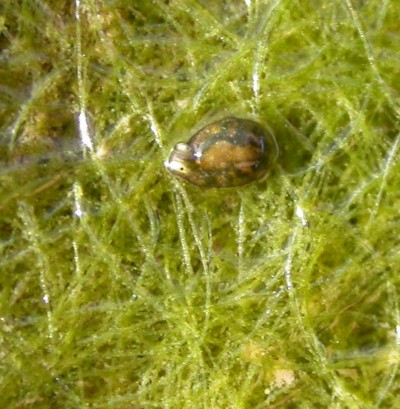
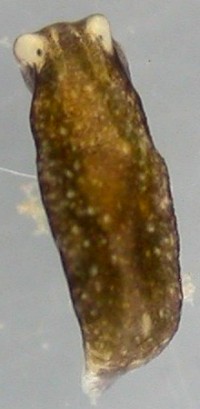
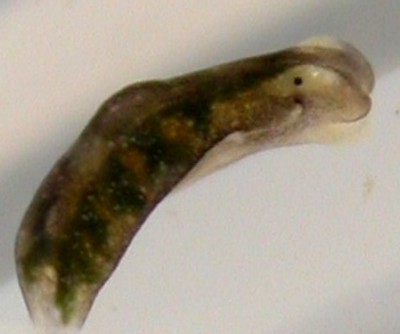
Dear Ian,
Thanks for these interesting photos. As I said in your recent message on L. depressa [message #22743], differentiating between L. depressa and L. capitata could be tricky. Did you look at these animals with a binocular microscope? It would be interesting to know where the anus and renal openings were. Tom Thompson also mentions a pale yellowish variety of L. depressa [var pellucida Kevan] in which the mantle skin is devoid of most pigment and the branched digestive gland shows through as a dark shadow. Two of you photos show this quite clearly, but I don't know if L. depressa is the only species which has this variation. If it is then your animals may be that species.
Unfortunately I am not very familiar with these common northern hemisphere species. Perhaps Kathe Jensen, who worked on these animals some years ago can give her views.
Best wishes,
Bill Rudman
Re: Limapontia capitata
January 8, 2002
From: Kathe R. Jensen
Dear Mike and Bill,
So nice to see an old friend from "home". I did my master's thesis on Limapontia capitata 27 years ago. At 2 mm this specimen is almost certainly a juvenile. However, L. capitata does not have rhinophores; adults usually have distinct "crests" on the head. The species with rhinophores (simple, not auriculate) is L. senestra (previously known as L. cocksi or Acteonia cocksi).
It could very well be feeding on Bryopsis at Tjarnoe (one of those localities that are impossible to spell without a Scandinavian keyboard). However, it is more likely that it was feeding on a species of Cladophora, which is also finely filamentous, but has "cells" or septae, which are visible under low magnification.
This species must be very difficult to photograph. I realized that even after all these years I don't have a good picture. I think they move too fast for close-up photography.
Happy New Year to all,
Kathe
jensen@ait.ac.th
Jensen, K.R., 2002 (Jan 8) Re: Limapontia capitata. [Message in] Sea Slug Forum. Australian Museum, Sydney. Available from http://www.seaslugforum.net/find/5920Thanks Kathe,
Bill Rudman
Limapontia capitata
January 4, 2002
From: Mike Noren

This isn't really a request for ID, as I already know what it is. I noticed there weren't any of these guys on picture, and since I happened to have a pic handy...
This slug was was collected in late November 2001 at Tjärnö on the Swedish west coast, from filamentous algae growing just below the water line on a floating jetty. The slug was observed eating the algae. I'm not very good at identifying algae, but it looked like Bryopsis.
Size of the slug is about 2mm.
Mike Noren
mike_noren@hotmail.com
Noren,M., 2002 (Jan 4) Limapontia capitata. [Message in] Sea Slug Forum. Australian Museum, Sydney. Available from http://www.seaslugforum.net/find/5831Thanks Mike,
Another common European animal I am not very familiar with. Tom Thompson mentions that adults of this species have auriform rhinophoral tentacles which I can't see in your photo. Does that make yours a juvenile?
Best wishes,
Bill Rudman.
